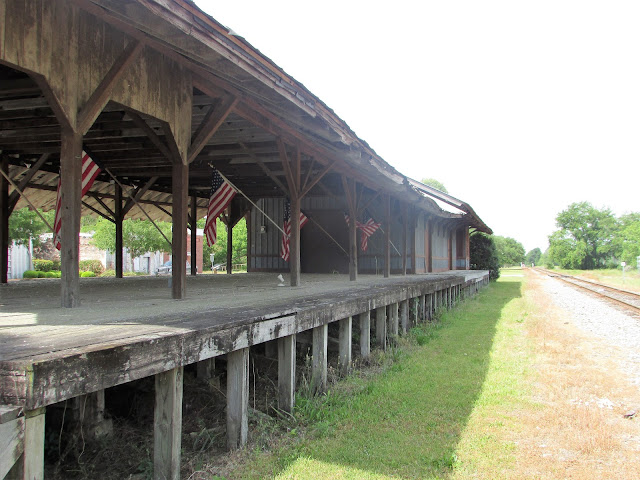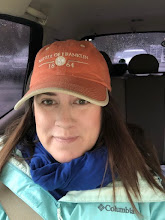Our first stop was in an adorable tiny town named Cope, SC. Cope is located in Orangeburg county and has a population of less than 100...I'm pretty sure we only saw 2 people while we were exploring.
Cope Depot, also known as the Manchester and Augusta Railroad Depot (1893).
Bank of Cope (1918).
The Bank of Cope prospered during its 15 years at this location. However, after President FDR's Bank Holiday in 1933, Orangeburg was left without a bank but have no fear the Bank of Cope saved the day. "Under the cover of the night" the bank property was loaded onto a truck and off to Orangeburg it went to set up the Bank of Cope in Orangeburg.
The inside of the bank.
Old Cotton Gin (1930s)
After leaving this adorable town, we headed to Denmark. I had been told if I ever found myself in Denmark, I should eat at Nelson's Wee Bake. Before having lunch in Denmark, we decided to walk around the town to see what kind of historical sites we could find.
This historic building was originally the AT&T Building (1923).
The Denmark Tea Room (1894). The Denmark Tea Room served meals to travelers who were staying at the Denmark Hotel. The tea room has now been restored and is the Jim Harrison art gallery. After walking around the town, we made our way to Nelson's Wee Bake. Nelson's is a tiny walk-in/take out only place. The lunch menu is limited (hot dogs, pulled pork sandwiches, etc.) because what they are known for is their desserts. When I walked into Nelson's to my right were shelves with different types of homemade breads and to my left was a case full of homemade desserts...needless to say it smelled amazing in there. Unfortunately, I had decided to make May a no sweets month so I had to pass on the sweets but the hot dogs we ordered for lunch were delicious. I'll be sure to find myself in Denmark after May in order to try some of the delicious looking desserts!
We stopped by Voorhees College which is located in Denmark. Voorhees College is a historically black college that was started in 1897 by Elizabeth Evelyn Wright. Mrs. Wright had attended Booker T. Washington's Tuskegee Institute. She was so inspired by Booker T. Washington that she made it her mission to assist/provide education in rural areas for African-American children. The campus is beautiful! There are many historical buildings and beautiful green spaces.
St. Phillip's Episcopal Chapel (1935).
Booker T. Washington Hall (1905)
Wright Hall.
Dr. George R. C. Todd's House. Dr. Todd was the brother of Mary Todd Lincoln. He was a surgeon in the Confederate Army.
Ryan House. The Ryan House was used as the headquarters for the Union Army when they stopped in Barnwell on their March to the Sea.
Gravesite of Brig. General Johnson Hagood (CSA). He was also the Governor of South Carolina from 1880-1882.
The Episcopal Church of the Holy Apostle (1856). Judson Kilpatrick (Union) while in Barnwell decided that this beautiful church was the perfect place to stable his horses. He then proceeded to use the baptismal as the watering trough for his horses.
Side Note: If you are interesting in learning more about Sherman's march through the Carolinas, I recommend reading A Carnival of Destruction: Sherman's Invasion of South Carolina by Tom Elmore.
Our last stop, of so we thought, was to Allendale county. One thing I didn't check on before we hit the road was if any of the places we had on our list to visit were having any festivals. Well sure enough, we were detoured when heading to Allendale due to them having their annual Cooter Festival...yep you read that correct their Cooter Festival. But this was a blessing because the detour put us on one of the roads we needed to go down anyway so thank you Allendale's Cooter Festival!
Our first stop on the outskirts of Allendale was to Smyrna Baptist Church (1827).
Smyrna Baptist Church was also known as Kirkland Church (named for the preacher at that time). There is some drama that took place in this church which resulted in the excommunication of some of its members in 1827. Apparently the members were excommunicated due to their differing views on communion as they believed that communion was open to everyone regardless of their denomination. The members of Smyrna Baptist Church believed that communion was for their members only.
Interested in what happened to the excommunicated members????
Well they formed their own church, of course!
Antioch Christian Church (1835).
Dr. J. D. Erwin's grave. He was the minister of Antioch Christian Church.
We decided to head into to Allendale although unsure as to what roads may be blocked due to the festival. While there were several road blocks, we were able to find a way to see Miss Arnold's School House.
Miss Arnold's School House (1875).
After a very full day of riding the back roads and exploring these great counties/towns, we decided to start our journey back to Columbia. Well that is until we passed a sign for Rivers Bridge State Park and then a historical marker. We definitely need the bumper sticker a friend told me about that reads, "this vehicle brakes for historical markers". My mister has the same sense of adventure as I do so there was no discussion he just turned the vehicle around and off we went again to explore.
J. J. Brabham, a signer of the secession ordinance.
We then made our way to Rivers Bridge State Historic Site located in Ehrhardt (& yes I received another stamp in my state park book). Rivers Bridge is a preserved Civil War battlefield. This was a 2 day battle that took place in 1865, where Confederate soldiers were trying to hold off Union soldiers from advancing through the South.
Rivers Bridge is a beautiful place to visit and is packed full of history. There are several wayside signs throughout the park that give information about the battle that took place. One of the wayside signs provides information about the post-Civil War reunions that continued through the 1960s at River Bridge. There was a quote on the sign that really spoke to me about one of the reunions, it read "It is the greatest annual gathering of the South, this voluntary meeting of the thousands to pledge unwavering loyalty to the truth of the past and the duty of the future" - The Barnwell People, May 4, 1899.
This adventure will go down in the books as one of my very favorite days! I hope you'll decide to get in your car and explore the back roads, you won't regret it.
Happy Travels,
Amber














































No Comments Yet, Leave Yours!